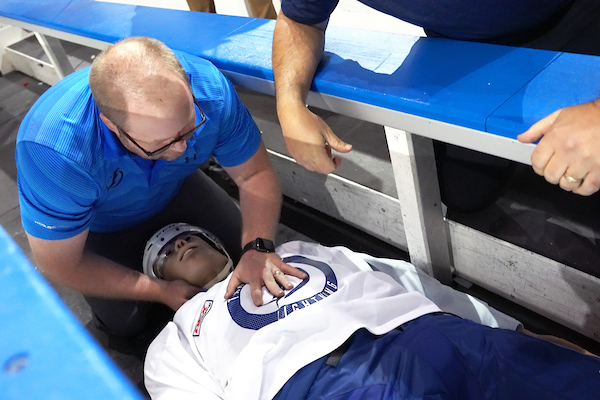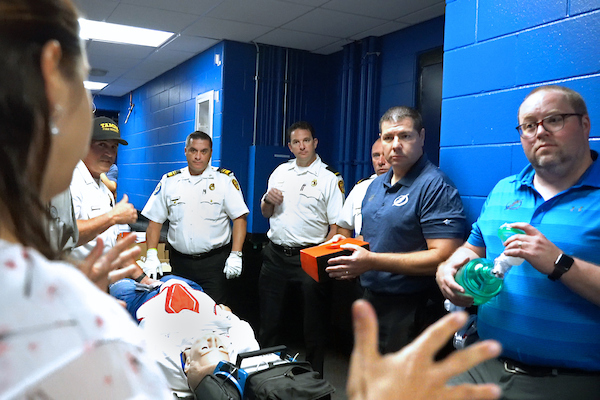]]>

(Left) Rishi Rane, MD, at his FIU Herbert Wertheim College of Medicine White Coat Ceremony. (Right) Dr. Rane performing in Il Mondo Della Luna in Cincinnati. Pre-Covid photos courtesy of Dr. Rane.
On March 14, 2021, the 63rd Annual GRAMMY Awards aired on CBS and one University of South Florida (USF) emergency medicine resident was particularly interested in who would win Best Opera Recording.
Music and medicine share the ability to heal and transform, and Rishi Rane, MD, emergency medicine resident, and trained professional tenor, practices both. Dr. Rane studied at the University of Miami (UM) Frost School of Music, and after graduation in 2009, moved to New York to pursue a career as an opera singer. The first year was rough, but eventually he landed several roles at the Bronx Opera and Opera America, at local places of worship, and even at the world-renown Metropolitan Opera, where he joined the company’s production of Aida, his favorite opera, as a non-singing supernumerary. “That was a really big deal because it was a dream of mine to sing at the Met,†Dr. Rane told Ileana Varela, associate director of marketing and PR at Florida International University (FIU).
Rishi Rane, MD, trained professional tenor, singing “Maria” from West Side Story. Pre-Covid Video.
After five years in music, Dr. Rane was starting to feel the burnout and decided to pursue a steadier and more reliable career in medicine. Medicine has always been part of Dr. Rane’s life since his mother is a Registered Nurse (RN) and his sister is a Physician Assistant (PA). Dr. Rane even worked in music therapy at the University of Florida (UF) Health Cancer Center in Orlando and found it to be an amazing experience where he could really connect with patients and help relieve their stress and anxiety. His path to a career in medicine began with a move back to his home state of Florida and enrollment into the FIU Herbert Wertheim College of Medicine. “As an opera singer, you memorize tons of lines and music,†Dr. Rane said. “I guess you could say that practice got me ready for med school.â€
During his fourth year of medical school, Dr. Rane’s music career came knocking in the form of an “out of the blue†email from the director of the Met. An old castmate recommended Dr. Rane and he was being asked to audition for George Gerwin’s classic American opera, Porgy and Bess. With the support and encouragement of his medical school advisor, Dr. Rane auditioned and was chosen to be in the show’s ensemble. “This was obviously a great opportunity and one that I couldn’t pass up, but that being said, medicine is what I saw myself doing,” Dr. Rane said. “After all, I’d come a long way and felt like I’d found a new passion in life.â€
With special permission from his advisor, Dr. Rane finished up his last year of medical school remotely while preforming at the Lincoln Center, completing an emergency medicine rotation at New York Presbyterian Hospital, and applying for his first residency program. “I’ve managed to find a way to keep music in my life through what may very well have been the most stressful time in medical school,†Dr. Rane said.
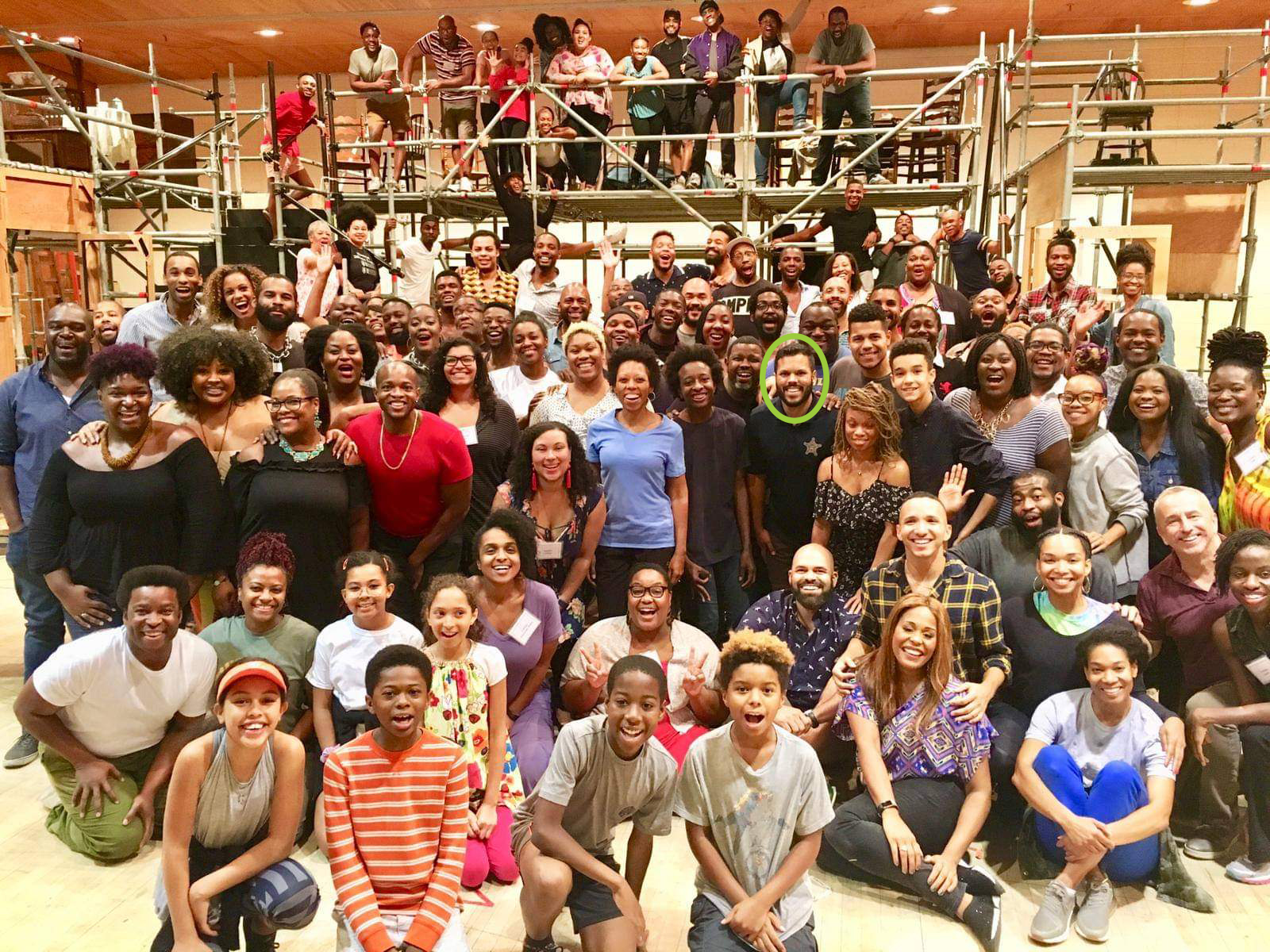
After three weeks of music and staging rehearsals in rehearsal rooms around the Met opera house, the cast of Porgy & Bess gets ready to move their final rehearsals to the stage. Pre-Covid photo courtesy of the Met opera chorus’ Facebook Page.
A scene from the final dress rehearsal of the Met’s production of The Gershwin’s Porgy and Bess. Pre-Covid Video.
According to Amazon’s editorial review for the 3-CD set audio recording of The Gershwins’ Porgy and Bess, the show was returning to the Met stage for the first time in nearly 30 years and ended up breaking company box-office records. The show was extended for an unprecedented three additional performances in February 2020. The production was also seen in cinemas around the world as part of the Met’s Live in HD series and seen by more than 325,000 people, making it one of the most successful transmissions in the series’ history.

The 3-CD set audio recording of The Gershwins’ Porgy and Bess as sold on Amazon.
Dr. Rane’s unique life experiences wouldn’t end there. He came back to Florida to start his prestigious three-year residency at Tampa General Hospital (TGH) as a part of the USF Health Morsani College of Medicine (MCOM) Emergency Medicine Residency Training Program. Only a few months into the coronavirus pandemic, Dr. Rane was stationed in TGH’s emergency department, among “the sickest of the sick, people on ventilators,†Dr. Rane told Joel Rozen, staff writer for the Met. “There are a lot of challenges the virus presents, but it also offers the opportunity to be creative. You’re multitasking and thinking on your feet, and the need to communicate with a lot of people at once reminds me of what I loved about performing.â€
Now, almost a year into Dr. Rane’s residency, one of his notable memories is, “getting the opportunity to run a successful code in the ICU and intubating and managing the care of a critical patient in the trauma bay for the first time,†Dr. Rane shared. “Some of my favorite memories outside of work have been simply having a meal and good conversation with faculty members, spending time with my amazing co-residents, going out on boat rides in Tampa Bay and exploring all that Tampa has to offer.â€
While continuing to endure the anxiety of the COVID-19 crisis, Dr. Rane’s music career came back around for more exciting news – the 2019 Metropolitan Opera recording of Porgy and Bess won the 2020 Grammy Award for Best Opera Recording. The recording was conducted by David Robertson and starred Angel Blue and Eric Owens. The cast also included Latonia Moore, Ryan Speedo Green, Alfred Walker, Golda Schultz, Denyce Graves, and the Metropolitan Opera Orchestra and Chorus. Dr. Rane and the rest of the members of the chorus and orchestra will receive a Grammy certificate while the 6 leading cast members and conductor will receive the iconic trophies. “I was overjoyed,†Dr. Rane said about the win. “We had all poured our heart and soul into that production, so this was just a testament to all of the hard work. Over the course of rehearsals and performances, I feel like my cast at the Metropolitan Opera became more like a family. Being part of that production as a fourth-year medical student was truly an incredible gift, and I feel so lucky to be given the opportunity to do it.â€
The Metropolitan Opera closed during the height of the pandemic in New York City and has remained closed to this day with plans of reopening in the Fall with the same production of Porgy and Bess. Dr. Rane and the original cast have all been invited back to perform in it, but unfortunately, Dr. Rane doesn’t think he is going to join. “I unfortunately don’t see my participation in it a possibility right now as residency is my priority,†Dr. Rane said. “That being the case, I have developed a good relationship with directors at the Met, so hopefully the door will remain open and I will be invited back to perform there again in the future.â€
At the end of a busy day at the hospital, Dr. Rane often sits down at his piano and sings to help de-stress. “I do see continuing to perform as a real possibility in the future and plan to continue singing and performing in some capacity after residency,†Dr. Rane said. “Whether that be putting on concerts or performing in a local theater company, I feel it’s important to find balance in life, and music certainly does that for me.â€
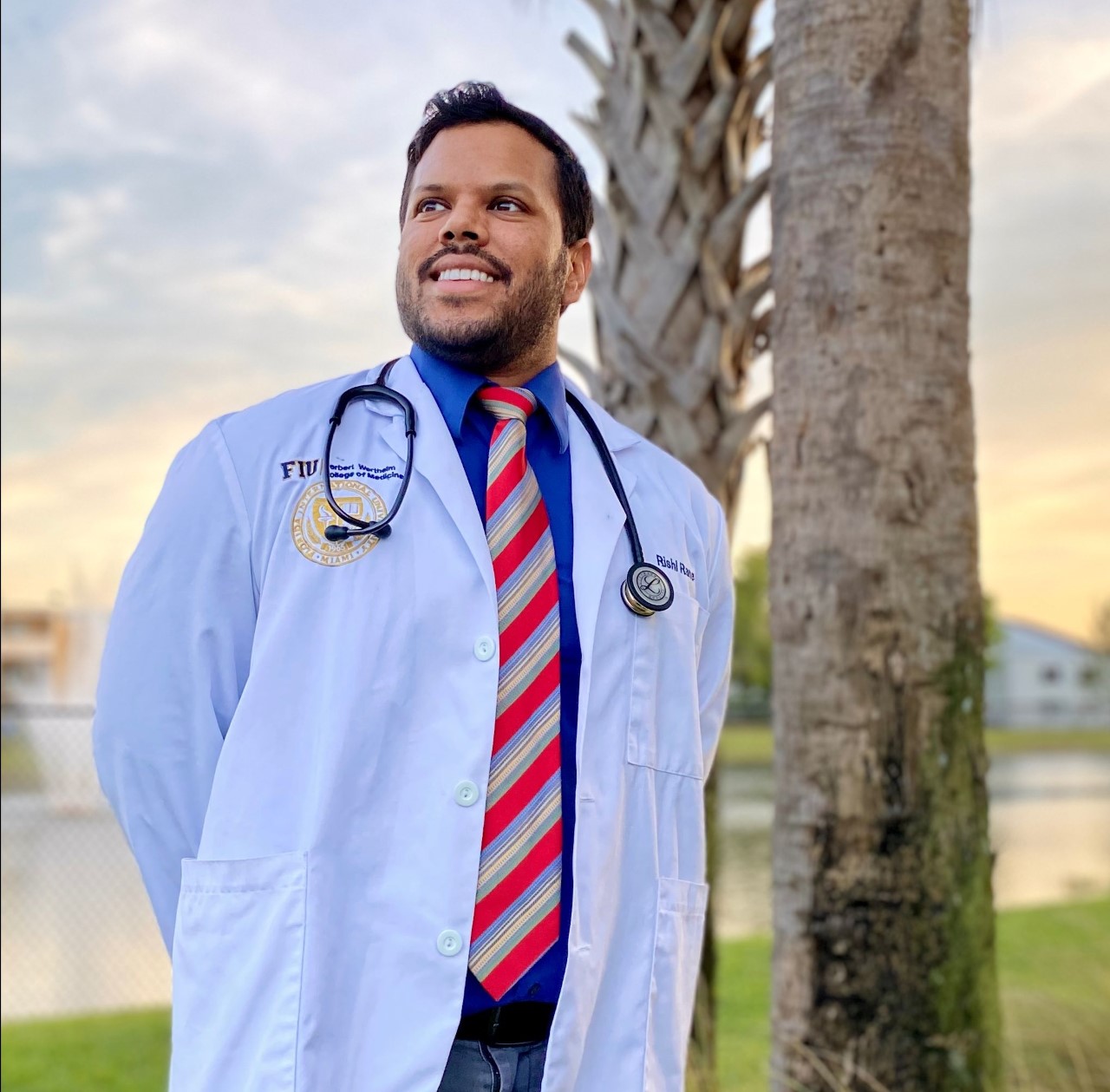
]]>
]]>
Inside four bustling rooms at USF Health Center for Advanced Medical Learning and Simulation (CAMLS), emergency medicine residents from USF Health, emergency nurses from Tampa General Hospital, and paramedics from Tampa Fire and Rescue worked together in simulation exercises to improve how they work as a team during intense emergency situations. Over the course of the day, the residents rotated through four scenarios: a patient with undifferentiated chest pain, a 5-year-old with complications from a snakebite, an infant with an unstable abnormal heartbeat, and a patient in cardiac arrest.
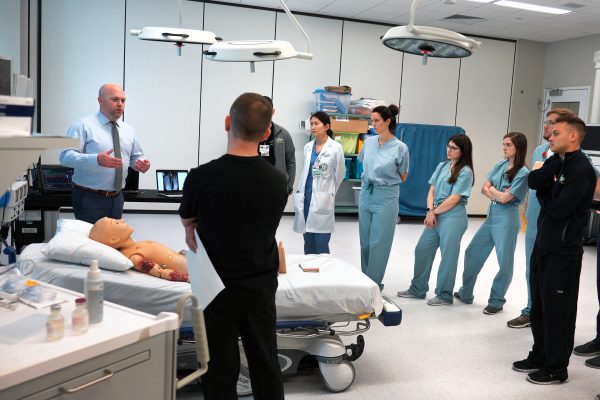
Ryan McKenna, DO, director of the interprofessional simulation fellowship at USF Health CAMLS and director of simulation for Emergency Medicine, guides participants through the snakebite simulation.

A team of emergency medicine residents from USF Health work together to help a manikin with undifferentiated chest pain.
The interprofessional team involved in the cardiac arrest simulation, practiced the process and communication of the transition from the pre-hospital team to the emergency department. This scenario was intentionally cut short after the first five minutes as a part of its educational design, also called scaffolding, said Ryan McKenna, DO, director of the interprofessional simulation fellowship at USF Health CAMLS and director of simulation for Emergency Medicine. The goal of this kind of teaching method is to make the information more manageable to retain by breaking up the lesson into segments. Not only does scaffolding avoid students becoming overloaded, but it also allows learners to identify subtle ways to improve that might be missed in a larger scenario.
“When you have focused efforts, you have a chunk of a component of that training that can now be brought into clinical practice and everyone has the same mental model and is applying it in the same way,†said Yasuharu “Haru†Okuda, MD, FACEP, FSSH, executive director of CAMLS and executive director of interprofessional education simulation programming for USF Health.
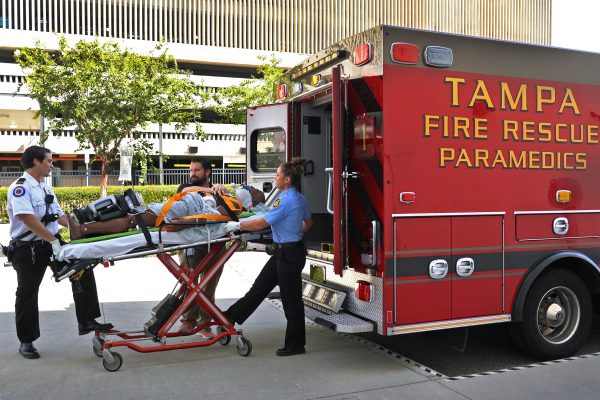
Paramedics from Tampa Fire and Rescue helped to bring the cardiac arrest simulation to life.
During one of the run-throughs of the cardiac arrest simulation, an observing resident noticed that the nurse performing chest compressions on the manikin might benefit from standing on a nearby stool to improve her ability to perform compressions. He brought it over to her and placed it by her feet, but the message about the height-assistance was lost in the chaotic sounds of the emergency department and she did not notice the stool was there until the end of the simulation. That is just a simple example of the kind of communication gaps that can result in a missed opportunity or medical error in a hospital and it’s a small area for improvement that would have been missed in a more complex simulation. Many of the residents reported back to Dr. McKenna that they were already using the skills they learned to improve the hand-off in the subsequent days following the simulation-based training.
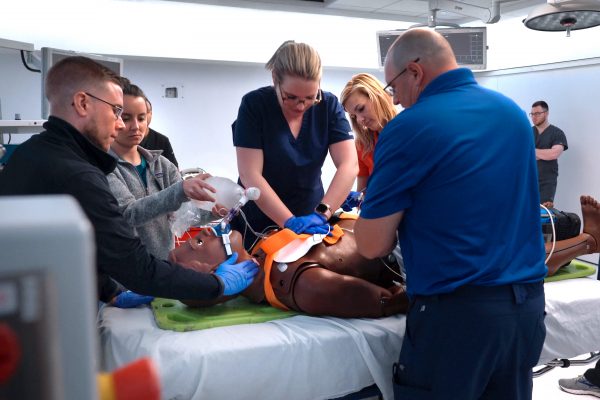
An interprofessional team including emergency medicine residents from USF Health, emergency nurses from Tampa General Hospital, and paramedics from Tampa Fire and Rescue, came together for simulation-based training.
In November 1999, the Quality of Health Care in America Committee of the Institute of Medicine (IOM) released a report called To Err is HuÂman: Building a Safer Health System that stated as many as 98,000 hospital deaths occur each year due to medical error. Communication error is described as the cause of 60% to 70% of those preventable hospital deaths.
“We’ve done a lot of amazing things in technology and medical knowledge and science, but I think one thing that we haven’t done well enough in health care is really learning to work together in teams,†Dr. Okuda said.
Twenty years after the IOM’s report, the statistics are still alarming. In an effort to make life better and combat medical errors, USF Health incorporates interprofessional education as a primary part of its curriculum.
“Especially in the ER, it’s a team discipline,†said Kelsey Hundley, MD, second-year emergency medicine resident with the USF Health Morsani College of Medicine. “Learning how to interact with people with different backgrounds and roles on the team is really important.â€

Kelsey Hundley, MD, second-year emergency medicine resident with the USF Health Morsani College of Medicine, works with her team to help the infant with an unstable abnormal heartbeat.
Simulation exercises as a part of interprofessional education allows participants to practice in a realistic but safe environment, both for the learners and for the patients.
“It was a pretty enjoyable experience,†said Adam Koby, MD, second-year emergency medicine resident with the USF Health Morsani College of Medicine. “We see these scenarios all the time in real life, but there’s always the opportunity to improve and I feel the way that you would improve the most is to practice those situations. During these simulations, we learn about individual pathologies, but more importantly, about team building.â€
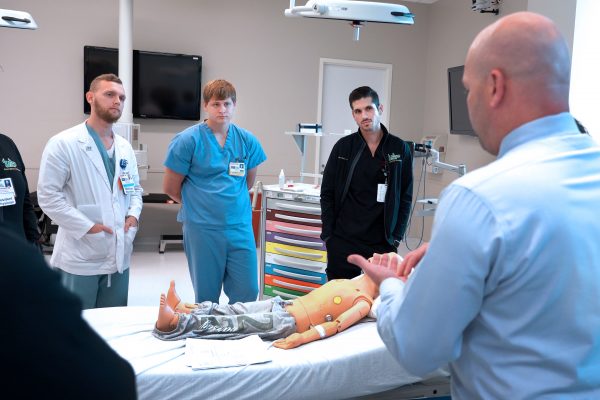
Adam Koby, MD, second-year emergency medicine resident with the USF Health Morsani College of Medicine (right), listens to Dr. McKenna during the debrief of the snakebite simulation.
When the various medical professions came together and were working in a training environment, “I saw smiles, energy and enthusiasm and I’ll bet you, for many of these folks, they won’t forget this,†Dr. Okuda said. “They shared the passion and I think coming together outside the clinical environment often builds stronger teams. So beyond just the training, there are the personal connections and the bonds that were created through this environment and interaction.â€
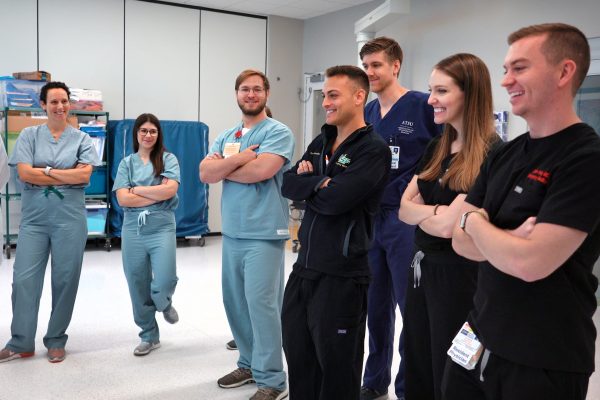
Participants shared laughs and smiles during the simulation-based training held at the USF Health Center for Advanced Medical Learning and Simulation.
]]>
]]>
When the hockey player is a high-tech manikin, medical professionals take emergency training to a whole new level
//www.youtube.com/watch?v=AI3DpKOFZTI
The USF Health Center for Advanced Medical Learning and Simulation brought an advanced patient simulator to Amalie Arena Sept. 10 so that Tampa Bay Lightning team physicians and athletic trainers, Tampa Fire Rescue paramedics, and a few USF Health emergency medicine trainees at Tampa General Hospital could more realistically practice life-saving stabilization procedures on the ice.

At the beginning of a simulation scenario, Tom Mulligan, head athletic trainer for the Tampa Bay Lightning, rushes over to an injured “player” down on the ice.
The simulation scenarios were performed on a life-like manikin, fully outfitted in Lightning gear, with laptop-controlled breathing, heart rates and pulses, eyes that could blink and dilate, and an artificial tongue that mimicked a real one. The training exercises included simulations of heart rhythm disturbances and cardiac arrest, as well as airway trauma from a neck injury. An ambulance was standing by just like during actual Lightning games.
“This was a first for us,†said Tom Mulligan, head athletic trainer for the Tampa Bay Lightning. “I’m only aware of one other team that uses a simulator for these rehearsals that we all do.â€

From the players’ bench area, the emergency response team prepares to lift the patient simulator strapped to a long board to immobilize the cervical spine.
The annual training helps prepare participants how to respond more effectively as a team in the rare event that an actual hockey player needs emergency care during a game.
For the last few years, the Lightning’s medical staff, paramedics who cover the games and TGH/TEAM Health emergency physicians would talk through scenarios and someone dressed up as a player for the practice. However, team members could not intubate, do cardiopulmonary resuscitation, or perform other emergency procedures on a human being.
“One common theme I kept hearing tonight was practicing with the simulator was a great experience. It really took our training to the next level – a whole new learning curve,†Mulligan said. “We’re extremely fortunate to have USF and CAMLS nearby, literally in our backyard, as a resource.â€

Andre Nelson, simulation operations specialist at USF Health CAMLS, looks over the manikin’s computer-programmed medical emergency with CAMLS Executive Director Haru Okuda, MD
Ryan McKenna, DO, simulation director for USF Health’s emergency medicine residency program, helped lead the training on the ice, players’ bench and arena tunnel with CAMLS providing simulation equipment and technical support.
“With this in situ simulation training, we were trying to integrate people from multiple domains and specialties into a unique environment that not everyone practices in on a day-to-day basis,†Dr. McKenna said. “The coolest thing for me was seeing a whole bunch of medical professionals come together to improve process and response times.â€
Haru Okuda, MD, the new executive director of USF Health CAMLS, said the center was excited to partner with the Lightning for this first training and looks forward to more opportunities to engage with the Tampa Bay community.
Every team member participating in the training at Amalie Arena is an expert in their discipline and in a familiar setting like the emergency room the simulation scenarios would have likely unfolded with ease, Dr. Okuda said. “But, because here they are in such a foreign environment, with helmet and pads and skates to deal with, you can see what a challenge it can be. Even the experts initially struggled with how to manage the ‘patient.’â€
Fortunately, the team is working on a manikin, not an actual player. And they can practice more than once.
“Once they run through a scenario and realize that some of the ways they would normally approach a problem aren’t working, then they are able to restart and try a different way to produce a better patient outcome,†Dr. Okuda said. “So, when the player has a real-life emergency, they can assess it and respond the best possible way.â€

Ryan McKenna, DO (center), director of simulation training for the USF Health emergency medicine residency, speaks to the team at a debrief following one of the simulation scenarios.

Jason Wilson, MD, (right) associate medical director of the Emergency Department at Tampa General Hospital, listens to Dr. McKenna lead the debrief.

Rachel Semmons, MD, an emergency physician at TGH/TEAM Health and assistant program director of USF Health’s emergency medicine residency, contributes to the debrief. Dr. Semmons is also co-medical director of Tampa Fire Rescue and USF’s EMS fellowship director.

Diego Riveros, MD, (left) a second-year emergency medicine resident at USF Health, and Anish Zachariah, MD, of TGH/TEAM Health, who directs the third-year emergency medicine clerkship for USF Health medical students.
-Video and photos by Torie M. Doll, USF Health Communications and Marketing
]]>



